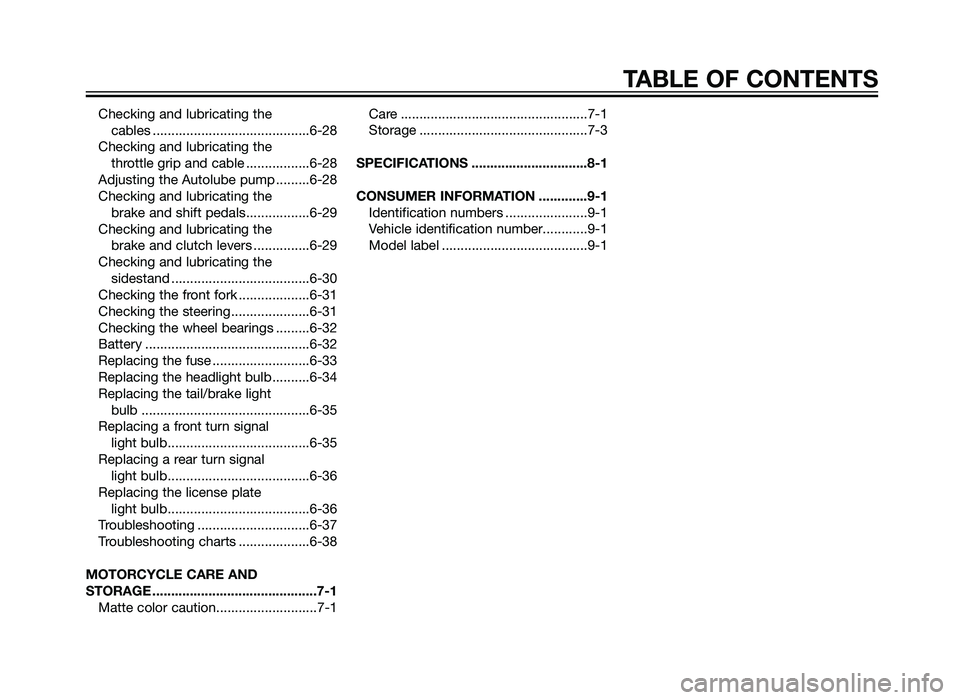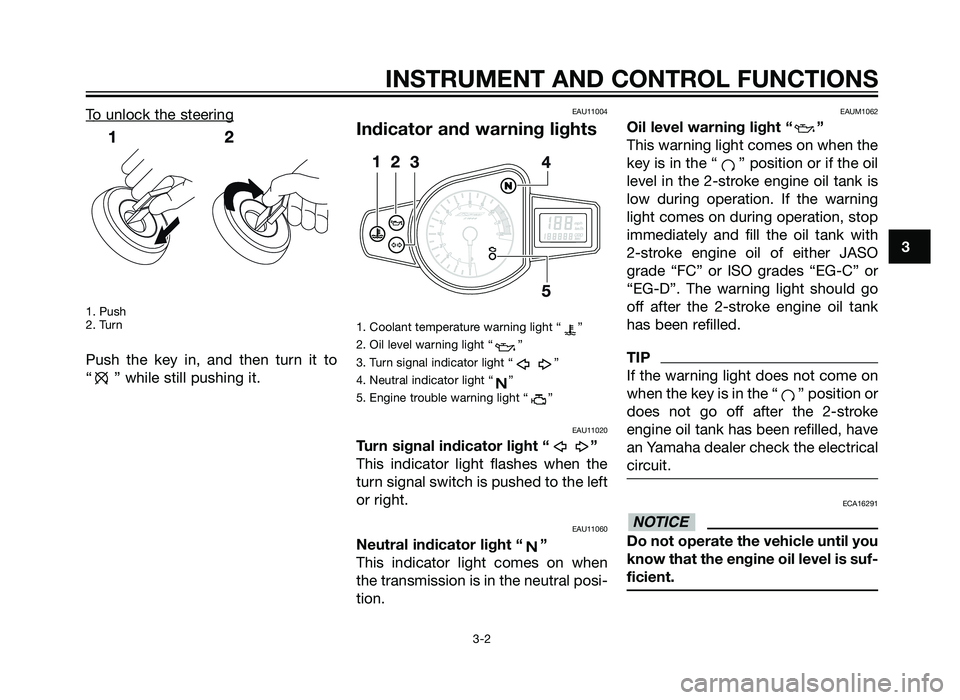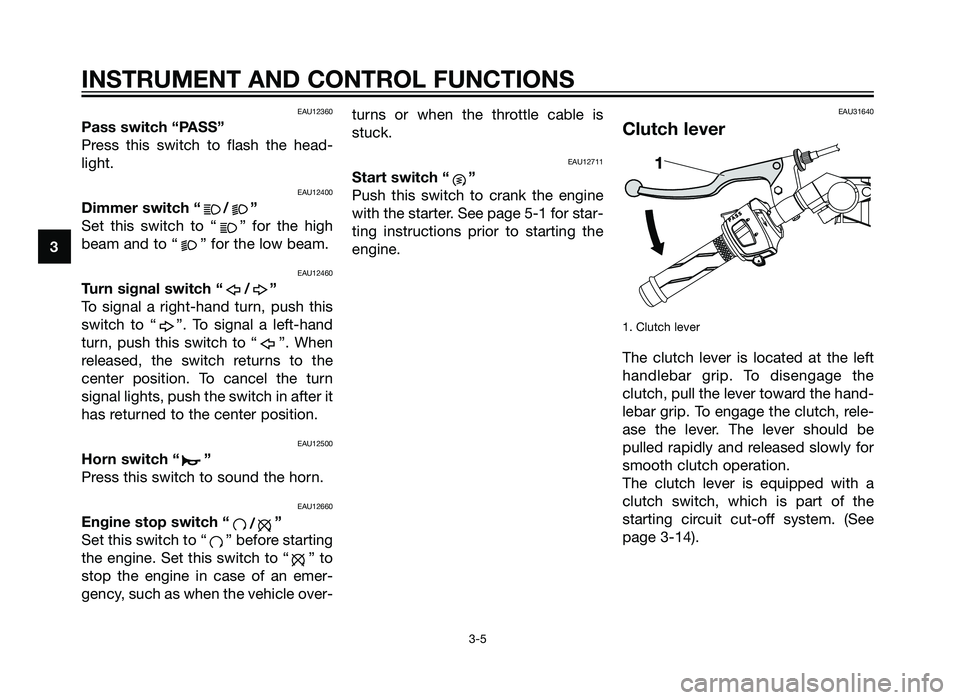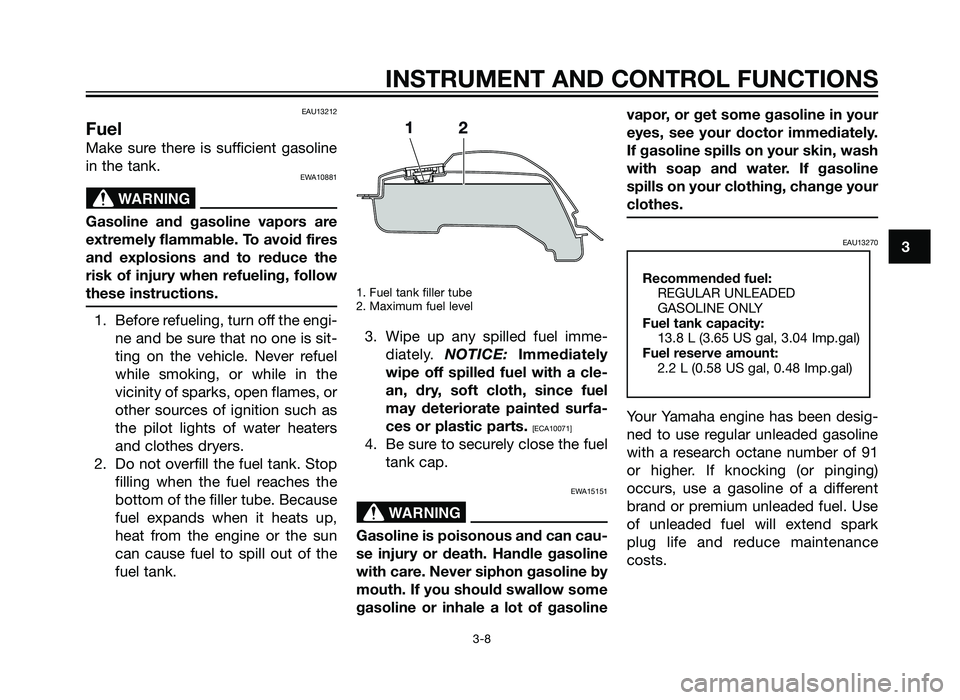light YAMAHA TZR50 2012 Owners Manual
[x] Cancel search | Manufacturer: YAMAHA, Model Year: 2012, Model line: TZR50, Model: YAMAHA TZR50 2012Pages: 92, PDF Size: 5.1 MB
Page 6 of 92

SAFETY INFORMATION .....................1-1
DESCRIPTION.....................................2-1Left view ...........................................3-1
Right view .........................................3-1
Controls and instruments .................3-1
INSTRUMENT AND CONTROL
FUNCTIONS ........................................3-1 Main switch/steering lock .................3-1
Indicator and warning lights .............3-2
Turn signal indicator light ................3-2
Neutral indicator light ......................3-2
Oil level warning light ......................3-2
Coolant temperature warning light ...............................................3-3
Engine trouble warning light ............3-3
Speedometer unit .............................3-3
Tachometer .......................................3-4
Handlebar switches ..........................3-4
Pass switch ......................................3-5
Dimmer switch .................................3-5
Turn signal switch ............................3-5
Horn switch .....................................3-5
Engine stop switch ..........................3-5
Start switch ......................................3-5
Clutch lever .......................................3-5
Shift pedal.........................................3-6
Brake lever ........................................3-6
Brake pedal.......................................3-6
Fuel tank cap ....................................3-7 Fuel ...................................................3-8
Fuel tank breather/overflow hose .....3-9
Catalytic converter............................3-9
2-stroke engine oil ..........................3-10
Fuel cock ........................................3-11
Starter (choke) lever ......................3-12
Seat.................................................3-12
Anti-theft device housing................3-13
Rear view mirrors ............................3-13
Sidestand ........................................3-14
Ignition circuit cut-off system .........3-14
FOR YOUR SAFETY –
PRE-OPERATION CHECKS ...............4-1
OPERATION AND IMPORTANT
RIDING POINTS ..................................5-1 Starting a cold engine ......................5-1
Starting a warm engine ....................5-2
Shifting ..............................................5-2
Tips for reducing fuel consumption..................................5-3
Engine break-in.................................5-3
Parking ..............................................5-4
PERIODIC MAINTENANCE AND
ADJUSTMENT ....................................6-1 Owner’s tool kit .................................6-1
Periodic maintenance chart for the emission control system .........6-3 General maintenance and
lubrication chart ............................6-4
Removing and installing cowlings and panels .....................................6-8
Checking the spark plug ................6-11
Transmission oil ..............................6-13
Coolant ...........................................6-14
Air filter element ..............................6-17
Adjusting the carburetor .................6-17
Adjusting the engine idling speed..........................................6-18
Adjusting the throttle grip free play .......................................6-18
Tires ................................................6-19
Cast wheels ....................................6-21
Adjusting the clutch lever free play .......................................6-21
Checking the front brake lever free play .......................................6-22
Adjusting the brake pedal free play .......................................6-22
Adjusting the shift pedal position ...6-22
Brake light switches .......................6-23
Checking the front and rear brake pads ..................................6-23
Checking the brake fluid level ........6-24
Changing the brake fluid ................6-25
Drive chain slack.............................6-25
Cleaning and lubricating the drive chain ............................................6-27
TABLE OF CONTENTS
1HD-F819D-E0 7/3/11 20:27 Página 6
2AS-F819D-E0.indd 631/07/12 10:09
Page 7 of 92

Checking and lubricating the cables ..........................................6-28
Checking and lubricating the throttle grip and cable .................6-28
Adjusting the Autolube pump .........6-28
Checking and lubricating the brake and shift pedals.................6-29
Checking and lubricating the brake and clutch levers ...............6-29
Checking and lubricating the sidestand .....................................6-30
Checking the front fork ...................6-31
Checking the steering.....................6-31
Checking the wheel bearings .........6-32
Battery ............................................6-32
Replacing the fuse ..........................6-33
Replacing the headlight bulb..........6-34
Replacing the tail/brake light bulb .............................................6-35
Replacing a front turn signal light bulb......................................6-35
Replacing a rear turn signal light bulb......................................6-36
Replacing the license plate light bulb......................................6-36
Troubleshooting ..............................6-37
Troubleshooting charts ...................6-38
MOTORCYCLE CARE AND
STORAGE ............................................7-1 Matte color caution...........................7-1 Care ..................................................7-1
Storage .............................................7-3
SPECIFICATIONS ...............................8-1
CONSUMER INFORMATION .............9-1 Identification numbers ......................9-1
Vehicle identification number............9-1
Model label .......................................9-1
TABLE OF CONTENTS
1HD-F819D-E0 7/3/11 20:27 Página 7
2AS-F819D-E0.indd 731/07/12 10:09
Page 11 of 92

1
SAFETY INFORMATION
1-4
of accessories not sold by Yamaha or
modifications not specifically recom-
mended by Yamaha, even if sold and
installed by a Yamaha dealer.
Aftermarket Parts, Accessories,
and Modifications
While you may find aftermarket pro-
ducts similar in design and quality to
genuine Yamaha accessories, recog-
nize that some aftermarket accesso-
ries or modifications are not suitable
because of potential safety hazards to
you or others. Installing aftermarket
products or having other modifica-
tions performed to your vehicle that
change any of the vehicle’s design or
operation characteristics can put you
and others at greater risk of serious
injury or death. You are responsible
for injuries related to changes in the
vehicle.
Keep the following guidelines in mind,
as well as those provided under “Loa-
ding” when mounting accessories.
�Never install accessories or carry
cargo that would impair the per-
formance of your motorcycle.
Carefully inspect the accessorybefore using it to make sure that
it does not in any way reduce
ground clearance or cornering
clearance, limit suspension tra-
vel, steering travel or control ope-
ration, or obscure lights or reflec-
tors.
• Accessories fitted to the hand- lebar or the front fork area can
create instability due to impro-
per weight distribution or
aerodynamic changes. If
accessories are added to the
handlebar or front fork area,
they must be as lightweight as
possible and should be kept to
a minimum.
• Bulky or large accessories may seriously affect the stability of
the motorcycle due to aerody-
namic effects. Wind may
attempt to lift the motorcycle,
or the motorcycle may become
unstable in cross winds. These
accessories may also cause
instability when passing or
being passed by large vehicles.
• Certain accessories can dis- place the operator from his or her normal riding position. This
improper position limits the fre-
edom of movement of the ope-
rator and may limit control abi-
lity, therefore, such
accessories are not recom-
mended.
• Use caution when adding elec- trical accessories. If electrical
accessories exceed the capa-
city of the motorcycle’s electri-
cal system, an electric failure
could result, which could cau-
se a dangerous loss of lights or
engine power.
Aftermarket Tires and Rims
The tires and rims that came with your
motorcycle were designed to match
the performance capabilities and to
provide the best combination of
handling, braking, and comfort. Other
tires, rims, sizes, and combinations
may not be appropriate. Refer to
page 6-19 for tire specifications and
more information on replacing your
tires.
1HD-F819D-E0 7/3/11 20:27 Página 11
2AS-F819D-E0.indd 1131/07/12 10:09
Page 16 of 92

INSTRUMENT AND CONTROL FUNCTIONS
3-1
3
EAU10460
Main switch/steering lock
The main switch/steering lock con-
trols the ignition and lighting systems,
and is used to lock the steering. The
various positions are described
below.
EAU10640
ON
All electrical circuits are supplied with
power, and the engine can be started.
The key cannot be removed.
TIP
The headlight, meter lighting and tai-
llight come on automatically when the
engine is started.
EAU10661
OFF
All electrical systems are off. The key
can be removed.
EWA10061
Never turn the key to “ ” or “ ”
while the vehicle is moving. Other-
wise the electrical systems will be
switched off, which may result in
loss of control or an accident.
EAU10683
LOCK
The steering is locked, and all electri-
cal systems are off. The key can be
removed.T
o lock the steering
1. Push
2. Turn
1. Turn the handlebars all the way to
the left.
2. Push the key in from the “ ” position, and then turn it to
“ ” while still pushing it.
3. Remove the key.
WARNING
1HD-F819D-E0 7/3/11 20:27 Página 16
2AS-F819D-E0.indd 1631/07/12 10:09
Page 17 of 92

To unlock the steering
1. Push
2. Turn
Push the key in, and then turn it to
“ ” while still pushing it.
EAU11004
Indicator and warning lights
1. Coolant temperature warning light “ ”
2. Oil level warning light “ ”
3. Turn signal indicator light “ ”
4. Neutral indicator light “ ”
5. Engine trouble warning light “ ”
EAU11020
Turn signal indicator light “ ”
This indicator light flashes when the
turn signal switch is pushed to the left
or right.
EAU11060
Neutral indicator light “ ”
This indicator light comes on when
the transmission is in the neutral posi-
tion.
EAUM1062
Oil level warning light “ ”
This warning light comes on when the
key is in the “ ” position or if the oil
level in the 2-stroke engine oil tank is
low during operation. If the warning
light comes on during operation, stop
immediately and fill the oil tank with
2-stroke engine oil of either JASO
grade “FC” or ISO grades “EG-C” or
“EG-D”. The warning light should go
off after the 2-stroke engine oil tank
has been refilled.
TIP
If the warning light does not come on
when the key is in the “ ” position or
does not go off after the 2-stroke
engine oil tank has been refilled, have
an Yamaha dealer check the electrical
circuit.
ECA16291
Do not operate the vehicle until you
know that the engine oil level is suf-
ficient.
NOTICE
INSTRUMENT AND CONTROL FUNCTIONS
3-2
3
1HD-F819D-E0 7/3/11 20:27 Página 17
2AS-F819D-E0.indd 1731/07/12 10:09
Page 18 of 92

EAU11446
Coolant temperature warning light
“”
This warning light comes on if the
engine overheats. If this occurs, stop
the engine immediately and allow the
engine to cool.
The electrical circuit of the warning
light can be checked by turning the
key to “ ”. The warning light should
come on for a few seconds, and then
go off.
If the warning light does not come
on initially when the key is turned to
“ ”, or if the warning light remains
on, have a Yamaha dealer check the
electrical circuit.
ECA10021
Do not continue to operate the
engine if it is overheating.
TIP
�For radiator-fan-equipped vehi-
cles, the radiator fan(s) automati-
cally switch on or off according to
the coolant temperature in the
radiator.
�If the engine overheats, see page
6-39 for further instructions.
EAUS1540
Engine trouble warning light “ ”
This warning light flashes if a problem
is detected in the electrical circuit
monitoring the engine. If this occurs,
have a Yamaha dealer check the self-
diagnosis system.
The electrical circuit of the warning
light can be checked by turning the
key to “ ”. If the warning light does
not come on for a few seconds, then
go off, have a Yamaha dealer check
the electrical circuit.
EAU11621
Speedometer unit
1. Speedometer
2. Odometer
UK ONLY
1. Speedometer
2. Odometer
NOTICE
INSTRUMENT AND CONTROL FUNCTIONS
3-3
3
1HD-F819D-E0 7/3/11 20:27 Página 18
2AS-F819D-E0.indd 1831/07/12 10:09
Page 20 of 92

EAU12360
Pass switch “PASS”
Press this switch to flash the head-
light.
EAU12400
Dimmer switch “ / ”
Set this switch to “ ” for the high
beam and to “ ” for the low beam.
EAU12460
Turn signal switch “ / ”
To signal a right-hand turn, push this
switch to “ ”. To signal a left-hand
turn, push this switch to “ ”. When
released, the switch returns to the
center position. To cancel the turn
signal lights, push the switch in after it
has returned to the center position.
EAU12500
Horn switch “ ”
Press this switch to sound the horn.
EAU12660
Engine stop switch “/”
Set this switch to “ ” before starting
the engine. Set this switch to “ ” to
stop the engine in case of an emer-
gency, such as when the vehicle over- turns or when the throttle cable is
stuck.
EAU12711
Start switch “ ”
Push this switch to crank the engine
with the starter. See page 5-1 for star-
ting instructions prior to starting the
engine.
EAU31640
Clutch lever
1. Clutch lever
The clutch lever is located at the left
handlebar grip. To disengage the
clutch, pull the lever toward the hand-
lebar grip. To engage the clutch, rele-
ase the lever. The lever should be
pulled rapidly and released slowly for
smooth clutch operation.
The clutch lever is equipped with a
clutch switch, which is part of the
starting circuit cut-off system. (See
page 3-14).
INSTRUMENT AND CONTROL FUNCTIONS
3-5
3
1HD-F819D-E0 7/3/11 20:27 Página 20
2AS-F819D-E0.indd 2031/07/12 10:09
Page 23 of 92

EAU13212
Fuel
Make sure there is sufficient gasoline
in the tank.
EWA10881
Gasoline and gasoline vapors are
extremely flammable. To avoid fires
and explosions and to reduce the
risk of injury when refueling, follow
these instructions.
1. Before refueling, turn off the engi-ne and be sure that no one is sit-
ting on the vehicle. Never refuel
while smoking, or while in the
vicinity of sparks, open flames, or
other sources of ignition such as
the pilot lights of water heaters
and clothes dryers.
2. Do not overfill the fuel tank. Stop filling when the fuel reaches the
bottom of the filler tube. Because
fuel expands when it heats up,
heat from the engine or the sun
can cause fuel to spill out of the
fuel tank.
1. Fuel tank filler tube
2. Maximum fuel level
3. Wipe up any spilled fuel imme-diately. NOTICE: Immediately
wipe off spilled fuel with a cle-
an, dry, soft cloth, since fuel
may deteriorate painted surfa-
ces or plastic parts.
[ECA10071]
4. Be sure to securely close the fuel tank cap.
EWA15151
Gasoline is poisonous and can cau-
se injury or death. Handle gasoline
with care. Never siphon gasoline by
mouth. If you should swallow some
gasoline or inhale a lot of gasoline vapor, or get some gasoline in your
eyes, see your doctor immediately.
If gasoline spills on your skin, wash
with soap and water. If gasoline
spills on your clothing, change your
clothes.
EAU13270
Your Yamaha engine has been desig-
ned to use regular unleaded gasoline
with a research octane number of 91
or higher. If knocking (or pinging)
occurs, use a gasoline of a different
brand or premium unleaded fuel. Use
of unleaded fuel will extend spark
plug life and reduce maintenance
costs.
Recommended fuel:
REGULAR UNLEADED
GASOLINE ONLY
Fuel tank capacity: 13.8 L (3.65 US gal, 3.04 Imp.gal)
Fuel reserve amount: 2.2 L (0.58 US gal, 0.48 Imp.gal)
WARNING
WARNING
INSTRUMENT AND CONTROL FUNCTIONS
3-8
3
1HD-F819D-E0 7/3/11 20:27 Página 23
2AS-F819D-E0.indd 2331/07/12 10:09
Page 33 of 92

ITEMCHECKS PAGE
Chassis fasteners • Make sure that all nuts, bolts and screws are properly tightened.
• Tighten if necessary. —
Instruments, lights, signals • Check operation.
and switches• Correct if necessary. —
Engine stop switch
• Check operation. 3-4
Sidestand switch • Check operation of ignition circuit cut-off system.
• If system is not working correctly, have Yamaha dealer check vehicle. 3-14
FOR YOUR SAFETY – PRE-OPERATION CHECKS
4-3
4
1HD-F819D-E0 7/3/11 20:27 Página 33
2AS-F819D-E0.indd 3331/07/12 10:09
Page 34 of 92

EAU15951
Read the Owner’s Manual carefully to
become familiar with all controls. If
there is a control or function you do
not understand, ask your Yamaha
dealer.
EWA10271
Failure to familiarize yourself with
the controls can lead to loss of
control, which could cause an acci-
dent or injury.
EAU16055
Starting a cold engine
In order for the ignition circuit cut-off
system to enable starting, one of the
following conditions must be met:
�The transmission is in the neutral
position.
�The transmission is in gear with
the clutch lever pulled and the
sidestand up.
See page 3-14 for more information. 1. Turn the fuel cock lever to “ON”.
2. Turn the key to “ ” and make sure that the engine stop switch
is set to “ ”.
3. Shift the transmission into the neutral position. The neutral indi-
cator light should come on. If not,
ask a Yamaha dealer to check the
electrical circuit.
4. Turn the starter (choke) on and completely close the throttle.
(See page 3-12).
5. Start the engine by pushing the start switch.
If the engine fails to start, release
the start switch, wait a few
seconds, and then try again.
Each starting attempt should be as short as possible to preserve
the battery. Do not crank the
engine more than 10 seconds on
any one attempt.
6. After starting the engine, move the starter (choke) back halfway.
7. When the engine is warm, turn the starter (choke) off.
TIP
The engine is warm when it responds
quickly to the throttle with the starter
(choke) turned off.
ECA11042
For maximum engine life, never
accelerate hard when the engine is
cold!
NOTICE
WARNING
OPERATION AND IMPORTANT RIDING POINTS
5-1
5
1HD-F819D-E0 7/3/11 20:27 Página 34
2AS-F819D-E0.indd 3431/07/12 10:09